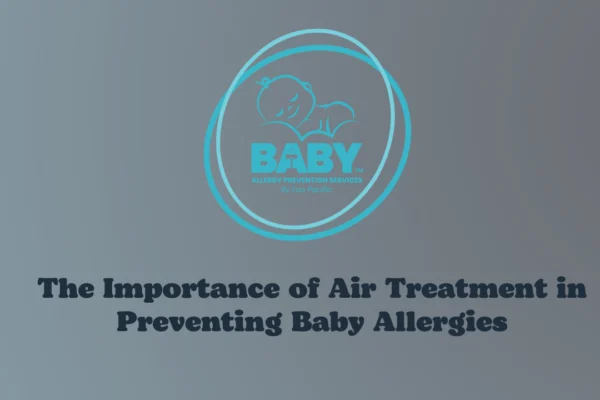The Importance of Air Treatment in Preventing Baby Allergies

- The Importance of Air Treatment in Preventing Baby Allergies
- Understanding Indoor Air Quality and Its Impact on Babies
- Common Indoor Allergens That Affect Babies
- The Role of Air Treatment Systems in Allergy Prevention
- Air Purifiers: Filtering Out Harmful Allergens
- Benefits of Using an Air Purifier for Babies
- Air Humidifiers: Maintaining Ideal Air Moisture Levels
- Benefits of Using an Air Humidifier for Babies
- Additional Steps to Improve Indoor Air Quality for Your Baby
- Regular Cleaning and Maintenance
- Ventilate Your Home Properly
When it comes to your baby’s health, creating a clean and allergen-free environment is essential. Since babies are more susceptible to irritants due to their developing immune systems, indoor air quality plays a significant role in their overall well-being. Common allergens such as dust, pet dander, mold spores, and pollen can easily circulate in the home and affect your baby’s respiratory health. Implementing air treatment solutions can help minimize exposure to these harmful allergens, making the air your baby breathes safer and cleaner. In this article, we explore how air treatment can help prevent baby allergies and support a healthier living space.
Understanding Indoor Air Quality and Its Impact on Babies
Indoor air quality (IAQ) refers to the cleanliness and purity of the air inside a building. Babies spend most of their early lives indoors, making them more vulnerable to the effects of poor air quality. According to health experts, air pollution is a major contributor to respiratory issues and allergic reactions. The air in your home may contain a variety of allergens that could trigger symptoms like sneezing, coughing, congestion, skin irritation, or even asthma in babies. Because their lungs and immune systems are still developing, babies are particularly sensitive to these airborne irritants.
Common Indoor Allergens That Affect Babies
- Dust mites: These tiny insects live in bedding, mattresses, carpets, and upholstered furniture. They thrive in warm and humid environments and are one of the leading causes of indoor allergies.
- Pollen: Pollen from trees, flowers, and grasses can enter your home through open windows or when you bring it in on clothing. This allergen can trigger symptoms like sneezing, watery eyes, and a runny nose.
- Pet dander: If you have pets, their skin flakes and saliva can become airborne and irritate your baby’s respiratory system, leading to allergic reactions.
- Mold spores: Mold grows in damp, humid conditions and releases spores into the air, which can irritate your baby’s respiratory system and cause allergic reactions.
Improving air quality by treating the air in your home can have a significant impact on reducing your baby’s exposure to these harmful allergens.
The Role of Air Treatment Systems in Allergy Prevention
Air treatment systems, such as air purifiers and air humidifiers, are designed to improve the quality of indoor air. These devices work by removing pollutants and allergens from the air, making the environment safer and healthier for your baby. Here’s how air treatment systems can help prevent allergies in babies:
Air Purifiers: Filtering Out Harmful Allergens
Air purifiers are equipped with filters that capture airborne particles, such as dust, pollen, pet dander, and mold spores. By using an air purifier in your baby’s room or throughout the home, you can significantly reduce the concentration of allergens in the air.
- HEPA filters: High-efficiency particulate air (HEPA) filters are one of the most effective types of filters used in air purifiers. HEPA filters are capable of capturing particles as small as 0.3 microns, making them highly effective at trapping allergens.
- Air filtration process: Air purifiers work by drawing in air, passing it through a filter, and releasing purified air back into the room. This process helps reduce the concentration of allergens and improves air quality, ensuring that your baby breathes cleaner air.
Benefits of Using an Air Purifier for Babies
- Relieves allergy symptoms: By removing airborne allergens, an air purifier can help relieve symptoms such as sneezing, coughing, and congestion, which are common in babies with allergies.
- Reduces exposure to asthma triggers: Asthma symptoms can be triggered by allergens like pet dander, mold, and dust mites. An air purifier can help reduce exposure to these triggers, minimizing the risk of asthma attacks in babies who are prone to the condition.
- Improves sleep quality: Babies with allergies often experience disrupted sleep due to congestion or discomfort. Clean air can improve sleep quality, helping your baby rest better.
Air Humidifiers: Maintaining Ideal Air Moisture Levels
Dry air can irritate the respiratory system and increase the risk of allergies and colds. This is especially true in areas with low humidity or during the winter months when indoor air tends to be drier. A humidifier adds moisture to the air, which can help alleviate dryness in your baby’s nasal passages, throat, and skin.
- Preventing dry skin and nasal congestion: Babies with dry skin or frequent nasal congestion can benefit from using a humidifier. By maintaining optimal humidity levels, humidifiers help prevent skin irritation, dryness, and discomfort caused by dry air.
- Soothing respiratory symptoms: When your baby experiences coughing or a dry cough due to allergies or a cold, a humidifier can help soothe their throat and ease breathing.
Benefits of Using an Air Humidifier for Babies
- Relieves congestion: Moist air helps open up the nasal passages, making it easier for babies to breathe, especially during allergy season or when they’re sick.
- Prevents skin dryness: Dry indoor air can lead to chapped skin and lips. A humidifier helps keep your baby’s skin hydrated and comfortable.
- Supports better sleep: By alleviating congestion and dry skin, a humidifier can create a more comfortable environment for your baby to sleep in.
Additional Steps to Improve Indoor Air Quality for Your Baby
In addition to using air treatment systems, there are several other steps you can take to improve indoor air quality and reduce allergens in your home:
Regular Cleaning and Maintenance
- Vacuum with a HEPA filter: Regularly vacuuming your floors, carpets, and upholstery with a vacuum cleaner equipped with a HEPA filter can help remove dust, pet dander, and other allergens that may be lurking in your home.
- Wash bedding frequently: Wash your baby’s bedding, blankets, and stuffed animals in hot water at least once a week to remove dust mites and other allergens.
- Dust regularly: Dust accumulates quickly in homes, so it’s important to dust frequently using a microfiber cloth that traps dust rather than spreading it around.
Ventilate Your Home Properly
- Open windows when possible: Proper ventilation helps to reduce indoor air pollutants. On days when the outdoor air quality is good, open your windows to allow fresh air to circulate.
- Use exhaust fans: In areas like the kitchen and bathroom, use exhaust fans to remove moisture and pollutants from the air.
Air treatment systems, including air purifiers and humidifiers, play a crucial role in preventing baby allergies by improving indoor air quality. By reducing allergens and maintaining optimal humidity levels, these devices help protect your baby from respiratory issues, skin irritations, and other allergy-related discomforts. In addition to using air treatment systems, regular cleaning, proper ventilation, and maintaining a clean home environment are essential steps in reducing exposure to harmful allergens. By taking these measures, you can ensure that your baby’s environment is healthy and safe, promoting better sleep, comfort, and overall well-being.







